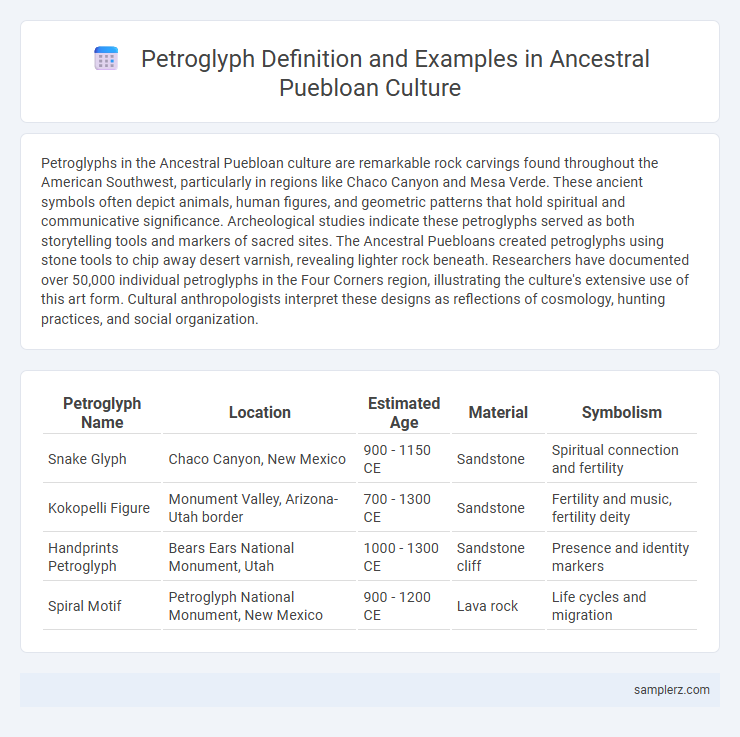Petroglyphs in the Ancestral Puebloan culture are remarkable rock carvings found throughout the American Southwest, particularly in regions like Chaco Canyon and Mesa Verde. These ancient symbols often depict animals, human figures, and geometric patterns that hold spiritual and communicative significance. Archeological studies indicate these petroglyphs served as both storytelling tools and markers of sacred sites. The Ancestral Puebloans created petroglyphs using stone tools to chip away desert varnish, revealing lighter rock beneath. Researchers have documented over 50,000 individual petroglyphs in the Four Corners region, illustrating the culture's extensive use of this art form. Cultural anthropologists interpret these designs as reflections of cosmology, hunting practices, and social organization.
Table of Comparison
| Petroglyph Name | Location | Estimated Age | Material | Symbolism |
|---|---|---|---|---|
| Snake Glyph | Chaco Canyon, New Mexico | 900 - 1150 CE | Sandstone | Spiritual connection and fertility |
| Kokopelli Figure | Monument Valley, Arizona-Utah border | 700 - 1300 CE | Sandstone | Fertility and music, fertility deity |
| Handprints Petroglyph | Bears Ears National Monument, Utah | 1000 - 1300 CE | Sandstone cliff | Presence and identity markers |
| Spiral Motif | Petroglyph National Monument, New Mexico | 900 - 1200 CE | Lava rock | Life cycles and migration |
Overview of Ancestral Puebloan Petroglyphs
Ancestral Puebloan petroglyphs, found primarily in the Four Corners region of the American Southwest, reveal intricate designs carved into sandstone surfaces. These petroglyphs depict ceremonial symbols, animals, and abstract motifs, providing insight into the spiritual and social lives of the Ancestral Puebloan people. Notable sites such as Chaco Canyon and Mesa Verde showcase these enduring artworks, illustrating the culture's deep connection to their environment and cosmology.
Significance of Rock Art in Puebloan Society
Petroglyphs such as the intricate spiral and animal carvings at Newspaper Rock provide vital insights into Ancestral Puebloan cosmology, social structure, and communication methods. These rock art pieces functioned as sacred symbols and messages, preserving spiritual narratives and community history across generations. The significance of these petroglyphs lies in their role as a cultural archive, reflecting the Puebloan worldview and facilitating social cohesion within the society.
Common Symbols in Ancestral Puebloan Petroglyphs
Common symbols in Ancestral Puebloan petroglyphs include spirals, handprints, and animal figures such as bighorn sheep, representing spiritual beliefs and hunting practices. These petroglyphs are often etched into sandstone cliffs throughout the Southwestern United States, especially in areas like Chaco Canyon and Mesa Verde. The intricate motifs reflect the community's connection to nature, cosmology, and social identity.
The Piedra Writing: Messages in Stone
The Piedra Writing petroglyphs, carved by the Ancestral Puebloans in the American Southwest, provide invaluable insights into their symbolic communication and spiritual beliefs. These intricate stone carvings feature abstract motifs, animal figures, and human forms, revealing ritualistic storytelling and territorial markings. Preserved in locations like Mesa Verde and Chaco Canyon, the Piedra Writing serves as a crucial archaeological record of Ancestral Puebloan culture and their connection to the land.
The Newspaper Rock Petroglyph Panel
The Newspaper Rock Petroglyph Panel, located in Utah's Canyonlands National Park, showcases over 650 petroglyphs created by the Ancestral Puebloan people, illustrating animals, human figures, and symbolic patterns. These petroglyphs serve as a vital cultural record, reflecting the spiritual beliefs, daily life, and historical events of the Ancestral Puebloans. Preservation of the panel offers critical insights into prehistoric communication and artistic expression within the broader Ancestral Puebloan culture.
The Chimney Rock Petroglyph Site
The Chimney Rock Petroglyph Site in Colorado features intricate rock carvings created by the Ancestral Puebloan people, serving as a significant cultural and spiritual landmark. These petroglyphs depict various symbols, including celestial motifs and animal figures, reflecting the community's connection to astronomy and nature. The site offers valuable insights into the ceremonial and daily life practices of the Ancestral Puebloan civilization.
Solar Markings and Astronomical Depictions
The Ancestral Puebloan culture features distinctive petroglyphs such as the Sun Dagger at Fajada Butte, which aligns with solar solstices and equinoxes, serving as an ancient solar calendar. These carefully carved solar markings demonstrate sophisticated understanding of astronomical cycles and celestial events. Astronomical depictions in their rock art include star patterns and lunar symbols that highlight the importance of celestial navigation and cosmology in Puebloan society.
Wildlife Representations in Puebloan Petroglyphs
Puebloan petroglyphs prominently feature wildlife representations such as deer, bighorn sheep, and raptors, symbolizing the deep spiritual connection between the Ancestral Puebloans and their natural environment. These animal depictions often indicate hunting practices, seasonal migrations, and clan symbols, serving both ritualistic and communicative purposes. The intricate carvings found at sites like Chaco Canyon and Mesa Verde provide critical insights into how wildlife shaped Puebloan cosmology and daily life.
Human and Ancestral Figures
Petroglyphs featuring human and ancestral figures are prominent within Ancestral Puebloan culture, often found in sites like Newspaper Rock in Utah and Chaco Canyon in New Mexico. These carved images illustrate complex social and spiritual narratives, depicting clan identities, ceremonial practices, and cosmological beliefs. The stylized anthropomorphic figures provide valuable insight into the cultural heritage and ancestral lineage of the Pueblo peoples.
Preservation of Ancestral Puebloan Petroglyph Sites
Preservation of Ancestral Puebloan petroglyph sites such as those found in the Petrified Forest National Park is critical to maintaining the cultural legacy of the indigenous people in the American Southwest. Conservation efforts include protective barriers, controlled access, and advanced documentation methods to prevent vandalism and natural erosion. These measures ensure that intricate petroglyphs, depicting symbolic motifs and daily life scenes, remain intact for ongoing archeological study and educational outreach.

example of petroglyph in Ancestral Puebloan culture Infographic
 samplerz.com
samplerz.com